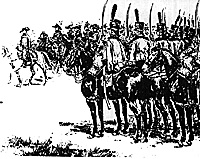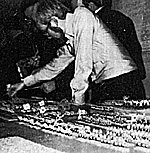
From September 1964 to May 1965, there appeared a five-part series in Table Top Talk, published by Jack Scruby, entitled Napoleonic Army Organization - Circa 1812, [NAO] written by Fred H. Vietmeyer of Fort Wayne, Indiana. This series of articles covered Army and unit organizations of the "big five" participants of the Napoleonic Wars - Britain, France, Prussia, Russia and Austria.
This series of articles, was the product of months of research and extensive overseas correspondence by Fred. In these articles he undertook to set out how and of what type units National armies were organized and also what type and number of units made up each regiment, battalion, and squadron of the army involved.
Each of the five countries involved was the subject of an article which gave a broad, but precise, overview of sub-unit type and member organization of that country's infantry, cavalry, and artillery. In addition, each article contained authorized strength figures and instructions for organizing war game units which would proportionately reflect the historical strength of the unit involved. These instructions included charts showing numbers and types of sub-units and the number of war game figures in each sub-unit.
Impact
The impact of these articles on Napoleonic wargaming in the U.S. was basic. For the first time, information was available about the basic type and number organization for major participants. It enabled wargamers to abandon the single organization-for-all-nations units, which were prevalent in American Napoleonic wargaming, and to re-organize regiments as they really existed.
Even more important was the introduction of the figure-to-historical muster ratio concept. In this concept, each figure represented a certain number of actual men and the total number of figures in the unit proportionately represented its historical strength. The figure-to-historical muster ratio which NAO established was 1:20. The American wargamer was now able to field Napoleonic wargame units which looked and acted like the real thing, and which were no longer just "carbon copies" of his opponent's units.
NAO became an appendix to the Midwestern Napoleonic Wargamers Confederation's rules, Column Line and Square (CLS), Edition 1, and became a part of CLS, 2d edition, with slight revisions. In 1973, CLS went into a 3d edition, called The Column, Line, and Square Battle Manual, by Judson T. Bauman and Fred H. Vietmeyer. Appendix 4 of the Battle Manual contains NAO in abbreviated form, and an indication that NAO was to be re-published in the future (which, at the time of this writing, has not yet occurred).
This writer, in revisiting NAO, has no desire to denigrate the work of Fred Vietmeyer in researching and making available to wargamers in this country and abroad information concerning Napoleonic era army organization and strengths. He did the work necessary at a time when resources were slim and scattered, and when no one else cared enough to pursue historical accuracy.
 He presented the concept of the figure-to-historical muster ratio system of wargaming unit organization, and its influence on wargaming in all periods has been profound and lasting. Fred is, and deserves to be, considered as a giant in American wargaming.
He presented the concept of the figure-to-historical muster ratio system of wargaming unit organization, and its influence on wargaming in all periods has been profound and lasting. Fred is, and deserves to be, considered as a giant in American wargaming.
Roger Homer prepares to move his troops in a moderate size CLS game.
NAO was researched, written and published 15 years ago. Since that time, it has become apparent that it contains errors. The increased availability of good secondary source material due to publication in the last 15-year span indicates that there may be other errors, problems and weaknesses in the basic material of NAO.
In fairness, it must be pointed out that Fred, from the beginning, has held NAO out only as a "guide''. But that status does not render an examination of its errors, problems, and weaknesses less cogent.
One problem is the selection of 1812 as the period for which to depict the Army organization of the 5 major powers of the Napoleonic Wars. In 1812, 2 of the 5 major powers -- Austria and Prussia -- were not at war. (I am disregarding the relatively small bodies of Prussians and Austrians who accompanied the Grand Army on the Russian campaign in 1812.) The selection of 1812 involves one in comparisons of strengths between armies which were at war -- with war-time establishments and field operations attrition; and armies which were not at war -- with peace-time establishments, severely limited by treaties with France, no general mobilization, and
no attrition due to active service occurring.
Why 1812?
It is difficult to determine why 1812 was chosen. In the period of 1809-1815 (this period is used because it is the period during which French infantry battalions were composed of 6 companies, as they are set out in NAO), all five countries were at war simultaneously, only in 1813, 1814, and 1815. 1815 could be discounted because Russia and Austria did not really participate in the 1815 campaign in a meaningful way. 1813 or 1814 would seem more logical
choices when attempting to determine ''average strengths" of military units of the "Big 5."
Years ago, when this writer asked Fred: "Why 1812?", no real answer was ever forthcoming. The writer's personal view has always been that it was because in 1964 (and for years after) Fred was the Midwestern Napoleonic Wargamers Confederation's French Commander-in-Chief,
and that 1812 was the zenith of the French Army.
In 1812, the French Army had the greatest number of units and the variety of types of unit. In addition, units of the Grand Army were at 100%+ of authorized strengths for the start of the Russian Campaign.
Another major problem with NAO is in its attempt to set forth "average strengths". NAO's forward (Table Top Talk, Sept. 1964) says: "One must remember that although the historical, theoretical paper organization of Napoleonic armies was fixed, the actual number of men per unit in the field was frequently radically different... Many exceptions can be noted, but an average as a guide for wargame armies will be attempted." It seems clear that NAO attempts to set forth a guide to what this article will refer to as average field strengths.
An examination of NAO indicates that French infantry battalions are organized at 81% of authorized strength, but cavalry squadrons at 100%. Prussian infantry battalions are organized at 100% of peace-time strength and Prussian cavalry squadrons likewise. Russian infantry battalions are organized at 50% of authorized strength and cavalry squadrons at 100%. All types of Austrian units are organized at 100% of authorized strengths. Patently, little success at arriving at "average strengths" or average field strengths was achieved.
An examination of errors and problems, both on a national basis, and in general, along with suggestions for solutions, follows.
More CLS
Back to Table of Contents -- Courier Vol. 1 #2
To Courier List of Issues
To MagWeb Master Magazine List
© Copyright 1979 by The Courier Publishing Company.
This article appears in MagWeb (Magazine Web) on the Internet World Wide Web.
Other military history articles and gaming articles are available at http://www.magweb.com